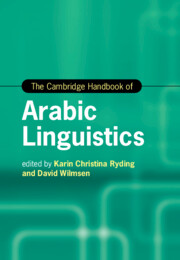Book contents
- The Cambridge Handbook of Arabic Linguistics
- Cambridge Handbooks in Language and Linguistics
- The Cambridge Handbook of Arabic Linguistics
- Copyright page
- Contents
- Figures
- Tables
- Notes on Contributors
- Acknowledgements
- Abbreviations
- Introduction
- Part I Arabic Applied Linguistics
- 1 Arabic Applied Linguistics
- 2 Language Planning in the Arab World in an Age of Anxiety
- 3 The Study of Arabic Language Acquisition
- 4 Issues in Arabic Language Testing and Assessment
- 5 Arabic Study Abroad
- 6 Models of Arabic Pronunciation
- Part II Arabic Variation and Sociolinguistics
- Part III Theoretical and Descriptive Studies
- Part IV Arabic Computational and Corpus Linguistics
- Part V Arabic Linguistics and New Media Studies
- Part VI Arabic Linguistics in Literature and Translation
- Index
- References
3 - The Study of Arabic Language Acquisition
A Critical Review
from Part I - Arabic Applied Linguistics
Published online by Cambridge University Press: 23 September 2021
- The Cambridge Handbook of Arabic Linguistics
- Cambridge Handbooks in Language and Linguistics
- The Cambridge Handbook of Arabic Linguistics
- Copyright page
- Contents
- Figures
- Tables
- Notes on Contributors
- Acknowledgements
- Abbreviations
- Introduction
- Part I Arabic Applied Linguistics
- 1 Arabic Applied Linguistics
- 2 Language Planning in the Arab World in an Age of Anxiety
- 3 The Study of Arabic Language Acquisition
- 4 Issues in Arabic Language Testing and Assessment
- 5 Arabic Study Abroad
- 6 Models of Arabic Pronunciation
- Part II Arabic Variation and Sociolinguistics
- Part III Theoretical and Descriptive Studies
- Part IV Arabic Computational and Corpus Linguistics
- Part V Arabic Linguistics and New Media Studies
- Part VI Arabic Linguistics in Literature and Translation
- Index
- References
Summary
This assessment of studies of Arabic child language acquisition shows the inescapable influence of diglossia on approaches to such study and its effects on children acquiring Arabic. Observing that studies of the acquisition of Arabic as a first language are necessary but lacking, they also note with some irony that some of the studies that have been conducted, of which investigations into the phonological development of Arab children are the most numerous, examine children’s spoken productions of the formal Arabic of writing and declamation, which includes sounds not shared by their native dialects of Arabic. While agreeing that it is necessary to consider children’s attention to the phonology of MSA as an integral dimension of their Arabophone environment and therefore part of the phonological repertoire of their native dialects, they also lament the dearth and small size of studies investigating native dialect acquisition. After phonology, much of the chapter is devoted to assessing the implications of Arabic root-and-pattern morphology in child recognition and acquisition of Arabic morphosyntax and the intriguing findings of such few studies that address such matters as, for example, the acquisition of gender and case marking.
Keywords
- Type
- Chapter
- Information
- The Cambridge Handbook of Arabic Linguistics , pp. 48 - 82Publisher: Cambridge University PressPrint publication year: 2021
References
- 1
- Cited by



